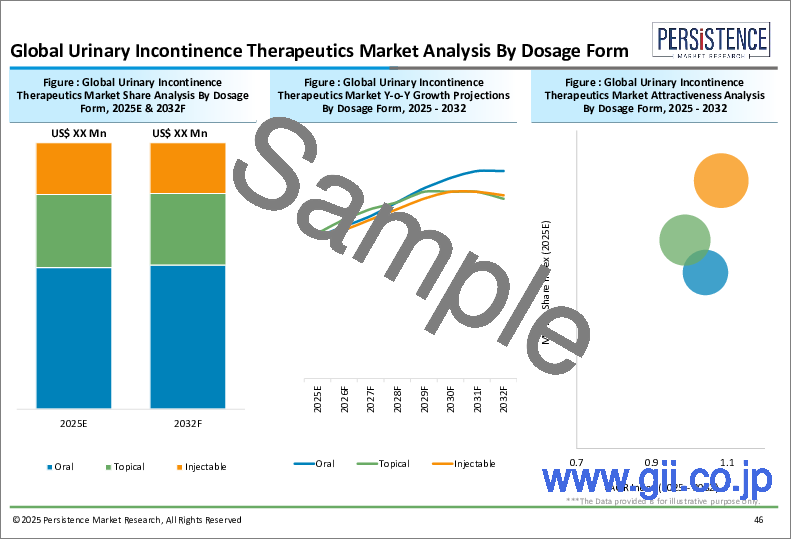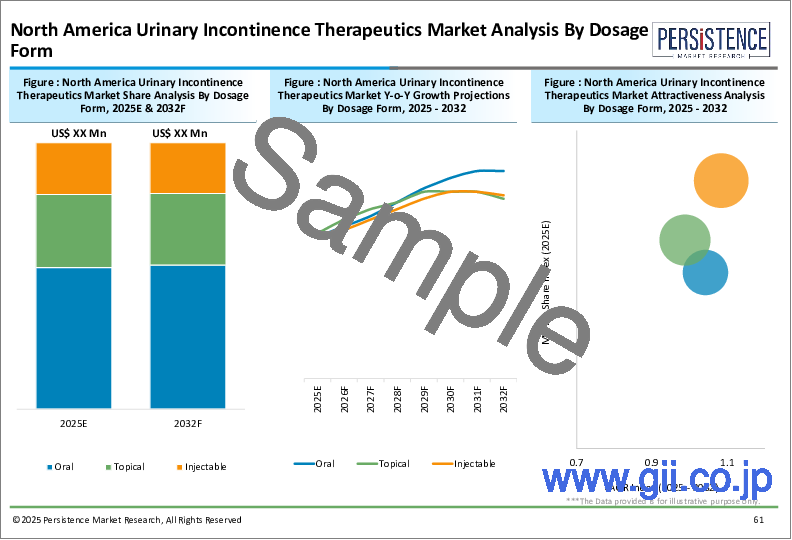|
|
市場調査レポート
商品コード
1559019
尿失禁治療市場:世界の産業分析、規模、シェア、成長、動向、2024~2031年予測Urinary Incontinence Therapeutics Market: Global Industry Analysis, Size, Share, Growth, Trends, and Forecast, 2024-2031 |
||||||
カスタマイズ可能
|
|||||||
| 尿失禁治療市場:世界の産業分析、規模、シェア、成長、動向、2024~2031年予測 |
|
出版日: 2024年09月16日
発行: Persistence Market Research
ページ情報: 英文 170 Pages
納期: 2~5営業日
|
全表示
- 概要
- 目次
Persistence Market Researchはこのほど、尿失禁治療の世界市場に関する包括的なレポートを発表しました。当レポートでは、市場促進要因・動向・機会・課題など、主要な市場力学を詳細に分析し、市場構造に関する詳細な洞察を提供しています。
主要な洞察
- 尿失禁治療の市場規模(2024年):44億米ドル
- 予測市場規模(2031年):58億米ドル
- 世界市場成長率(2024~2031年のCAGR):4.1%
尿失禁治療市場:調査範囲
尿失禁治療には、世界人口のかなりの部分が罹患している尿失禁の症状を管理・緩和するためにデザインされた様々な治療法が含まれます。これらの治療には、薬理学的治療、外科的介入、非薬理学的管理戦略が含まれます。この市場は、病院、クリニック、泌尿器科センター、在宅介護の環境を対象としており、抗コリン薬、β3アドレナリン作動薬、手術装置、骨盤底筋トレーニングなど、さまざまな治療オプションを提供しています。
市場促進要因:
世界の尿失禁治療市場は、高齢化社会における尿失禁の有病率の上昇や、利用可能な治療オプションに関する認知度の向上など、いくつかの重要な要因によって牽引されています。低侵襲手術技術や新規薬理学的薬剤などの治療技術の進歩により、治療効果と患者の満足度が向上しています。さらに、医療費の増加とともに、ライフスタイルの改善や行動療法の採用が増加していることも、市場の拡大に拍車をかけています。
市場抑制要因:
前向きな成長が見込まれるもの、尿失禁治療市場は、高額な治療費、限られた保険適用範囲、さまざまな治療法に対する患者の反応のばらつきなどに関連する課題に直面しています。特に医療予算に制約のある新興国では、高度な外科手術や長期の薬剤療法にかかる高額な費用が市場参入の障壁となる可能性があります。さらに、新規治療に対する規制上のハードルや厳しい承認プロセスが市場参入の障壁となり、技術革新のペースや市場成長に影響を与えています。
市場機会:
尿失禁治療市場は、現在進行中の研究開発、人口動態の変化、治療パラダイムの新興国市場開拓により、大きなビジネス機会をもたらしています。徐放性製剤や併用療法などの薬剤製剤の革新は、患者のコンプライアンスと治療成績の改善をもたらします。モバイルヘルスアプリケーションや遠隔医療を含むデジタルヘルス技術の統合は、治療やフォローアップケアへの患者のアクセスを向上させる。さらに、戦略的パートナーシップ、臨床試験への投資、費用対効果の高い治療ソリューションの開拓は、新たな機会を活用し、市場の成長を持続させる上で極めて重要です。
本レポートで扱う主要質問
- 世界の尿失禁治療市場の成長を促進する主要要因は何か?
- さまざまな医療環境で尿失禁治療の採用をリードしている治療タイプや治療様式は何か?
- 技術の進歩は尿失禁治療市場の競合情勢をどのように変えているのか?
- 尿失禁治療市場に貢献している主要参入企業は誰か、また市場の関連性を維持するためにどのような戦略を採用しているか?
- 世界の尿失禁治療市場の新たな動向と将来性は?
目次
第1章 エグゼクティブサマリー
第2章 市場概要
- 市場の範囲と定義
- 市場力学
- 促進要因
- 抑制要因
- 機会
- 課題
- 主要動向
- マクロ経済要因
- 世界のセクター別展望
- 世界のGDP成長展望
- 世界の医療費支出展望
- COVID-19の影響分析
- 予測要因-関連性と影響
第3章 付加価値の洞察
- 薬剤タイプの採用分析
- 規制状況
- バリューチェーン分析
- エンドユーザー/市場一覧
- 小売
- 聴覚学
- eコマース
- エンドユーザー(業界)リスト
- エンドユーザー/市場一覧
- 主要な取引と合併
- PESTLE分析
- ポーターのファイブフォース分析
第4章 尿失禁治療市場展望:実績(2019~2023年)と予測(2024~2031年)
- 市場規模(10億米ドル)と前年比成長率
- 絶対金額機会
- 市場規模(10億米ドル)の分析と予測
- 過去の市場規模(10億米ドル)分析、2019~2023年
- 現在の市場規模(10億米ドル)の分析と予測、2024~2031年
- 尿失禁治療市場展望:タイプ
- イントロダクション/主要調査結果
- 過去の市場規模(10億米ドル)分析、タイプ別、2019~2023年
- 現在の市場規模(10億米ドル)分析と予測、タイプ別、2024~2031年
- 切迫性尿失禁
- 溢流性失禁
- 腹圧性尿失禁
- 機能性失禁
- その他
- 市場の魅力分析:タイプ
- 尿失禁治療市場展望:薬剤クラス
- イントロダクション/主要調査結果
- 過去の市場規模(10億米ドル)分析、薬剤クラス別、2019~2023年
- 現在の市場規模(10億米ドル)の分析と予測、薬剤クラス別、2024~2031年
- 抗コリン薬
- ベータ3アドレナリン受容体作動薬
- アルファ遮断薬
- エストロゲン
- デスモプレシン
- 三環系抗うつ薬
- その他
- 市場の魅力分析:薬剤クラス
- 尿失禁治療市場展望:エンドユーザー
- イントロダクション/主要調査結果
- 過去の市場規模(10億米ドル)分析、エンドユーザー別、2019~2023年
- 現在の市場規模(10億米ドル)の分析と予測、エンドユーザー別、2024~2031年
- 病院
- 小売薬局
- オンライン薬局
- 市場の魅力分析:エンドユーザー
第5章 尿失禁治療市場展望:地域
- 2019~2023年における地域別市場規模(10億米ドル)の過去分析
- 現在の市場規模(10億米ドル)の分析と予測、地域別、2024~2031年
- 北米
- 欧州
- 東アジア
- 南アジアとオセアニア
- ラテンアメリカ
- 中東・アフリカ
- 市場の魅力分析:地域
第6章 北米の尿失禁治療市場展望:実績(2019~2023年)と予測(2024~2031年)
第7章 欧州の尿失禁治療市場展望:実績(2019~2023年)と予測(2024~2031年)
第8章 東アジアの尿失禁治療市場展望:実績(2019~2023年)と予測(2024~2031年)
第9章 南アジアとオセアニアの尿失禁治療市場展望:実績(2019~2023年)と予測(2024~2031年)
第10章 ラテンアメリカの尿失禁治療市場展望:実績(2019~2023年)と予測(2024~2031年)
第11章 中東・アフリカの尿失禁治療市場展望:実績(2019~2023年)と予測(2024~2031年)
第12章 競合情勢
- 市場シェア分析、2023年
- 市場構造
- 市場別の競合激化マップ
- 競合ダッシュボード
- 企業プロファイル(詳細-概要、財務、戦略、最近の動向)
- Pfizer Inc
- AbbVie Inc.
- Astellas Pharma Inc.
- Johnson &Johnson
- Viatris Inc.
- Teva Pharmaceutical Industries Ltd.
- Sanofi SA
- GlaxoSmithKline plc
- Boehringer Ingelheim Pharmaceuticals, Inc.
- Bayer AG
- Ferring Pharmaceuticals
第13章 付録
- 調査手法
- 調査の前提
- 頭字語と略語
Persistence Market Research has recently released a comprehensive report on the worldwide market for urinary incontinence therapeutics. The report provides an in-depth analysis of key market dynamics, including drivers, trends, opportunities, and challenges, offering detailed insights into the market structure.
Key Insights:
- Urinary Incontinence Therapeutics Market Size (2024E): US$4.4 Bn
- Projected Market Value (2031F): US$5.8 Bn
- Global Market Growth Rate (CAGR 2024 to 2031): 4.1%
Urinary Incontinence Therapeutics Market - Report Scope:
Urinary incontinence therapeutics encompass a range of treatments designed to manage and alleviate symptoms of urinary incontinence, a condition affecting a substantial portion of the global population. These therapeutics include pharmacological treatments, surgical interventions, and non-pharmacological management strategies. The market caters to hospitals, clinics, urology centers, and homecare settings, offering a variety of therapeutic options, including anticholinergics, beta-3 adrenergic agonists, surgical devices, and pelvic floor muscle training.
Market Growth Drivers:
The global urinary incontinence therapeutics market is driven by several key factors, including the rising prevalence of urinary incontinence among the aging population and increasing awareness about available treatment options. Advances in therapeutic technologies, such as minimally invasive surgical techniques and novel pharmacological agents, are enhancing treatment efficacy and patient satisfaction. Additionally, the growing adoption of lifestyle modifications and behavioral therapies, along with increasing healthcare expenditures, is fueling market expansion.
Market Restraints:
Despite positive growth prospects, the urinary incontinence therapeutics market faces challenges related to high treatment costs, limited insurance coverage, and variability in patient response to different therapies. The high cost of advanced surgical procedures and long-term pharmacological treatments can be a barrier to market accessibility, particularly in emerging economies with constrained healthcare budgets. Moreover, regulatory hurdles and stringent approval processes for new therapeutics contribute to market entry barriers, affecting the pace of innovation and market growth.
Market Opportunities:
The urinary incontinence therapeutics market presents significant opportunities driven by ongoing research and development, demographic shifts, and evolving treatment paradigms. Innovations in drug formulations, such as extended-release and combination therapies, offer improved patient compliance and therapeutic outcomes. The integration of digital health technologies, including mobile health applications and telemedicine, enhances patient access to treatment and follow-up care. Furthermore, strategic partnerships, investment in clinical trials, and the development of cost-effective treatment solutions are crucial to capitalizing on emerging opportunities and sustaining market growth.
Key Questions Answered in the Report:
- What are the primary factors driving the growth of the urinary incontinence therapeutics market globally?
- Which therapeutic types and treatment modalities are leading the adoption of urinary incontinence therapies across different healthcare settings?
- How are technological advancements reshaping the competitive landscape of the urinary incontinence therapeutics market?
- Who are the key players contributing to the urinary incontinence therapeutics market, and what strategies are they employing to maintain market relevance?
- What are the emerging trends and future prospects in the global urinary incontinence therapeutics market?
Competitive Intelligence and Business Strategy:
Leading players in the global urinary incontinence therapeutics market, including Pfizer Inc., Astellas Pharma Inc., Allergan plc, and Medtronic plc, focus on innovation, product differentiation, and strategic collaborations to gain a competitive edge. These companies invest in R&D to develop advanced therapeutic solutions, including novel drug formulations and innovative surgical devices, catering to diverse patient needs and clinical requirements. Partnerships with healthcare providers, regulatory agencies, and research institutions facilitate market access and promote technology adoption. Emphasis on clinical research, patient education, and personalized treatment approaches drives market growth and enhances patient outcomes in the evolving urinary incontinence therapeutics landscape.
Key Companies Profiled:
- Pfizer Inc.
- Astellas Pharma Inc.
- Allergan plc
- Medtronic plc
- Boston Scientific Corporation
- Coloplast A/S
- Urovant Sciences Ltd.
- Santen Pharmaceutical Co., Ltd.
- Endo International plc
- Kaken Pharmaceutical Co., Ltd.
Urinary Incontinence Therapeutics Industry Segmentation
By Type
- Urge Incontinence
- Overflow Incontinence
- Stress Incontinence
- Functional Incontinence
By Drug Class
- Anticholinergics
- Beta-3 Adrenoceptor Agonists
- Alpha Blockers
- Estrogen
- Desmopressin
- Tricyclic Antidepressants
By End User
- Hospitals
- Retail Pharmacy
- Online Pharmacy
By Region
- North America
- Europe
- East Asia
- South Asia & Oceania
- Latin America
- The Middle East & Africa
Table of Contents
1. Executive Summary
- 1.1. Urinary Incontinence Therapeutics Market Snapshot, 2024-2031
- 1.2. Market Opportunity Assessment, 2024-2031, US$ Mn
- 1.3. Key Market Trends
- 1.4. Future Market Projections
- 1.5. Premium Market Insights
- 1.6. Industry Developments and Key Market Events
- 1.7. PMR Analysis and Recommendations
2. Market Overview
- 2.1. Market Scope and Definition
- 2.2. Market Dynamics
- 2.2.1. Drivers
- 2.2.2. Restraints
- 2.2.3. Opportunity
- 2.2.4. Challenges
- 2.2.5. Key Trends
- 2.3. Macro-Economic Factors
- 2.3.1. Global Sectorial Outlook
- 2.3.2. Global GDP Growth Outlook
- 2.3.3. Global Healthcare Spending Outlook
- 2.4. COVID-19 Impact Analysis
- 2.5. Forecast Factors - Relevance and Impact
3. Value Added Insights
- 3.1. Drug Type Adoption Analysis
- 3.2. Regulatory Landscape
- 3.3. Value Chain Analysis
- 3.3.1. List of End-user/Marketplaces
- 3.3.1.1. Retail
- 3.3.1.2. Audiology
- 3.3.1.3. E-Commerce
- 3.3.2. List of End User (Industry)
- 3.3.1. List of End-user/Marketplaces
- 3.4. Key Deals and Mergers
- 3.5. PESTLE Analysis
- 3.6. Porter's Five Force Analysis
4. Urinary Incontinence Therapeutics Market Outlook: Historical (2019-2023) and Forecast (2024-2031)
- 4.1. Key Highlights
- 4.1.1. Market Size (US$ Bn) and Y-o-Y Growth
- 4.1.2. Absolute $ Opportunity
- 4.2. Market Size (US$ Bn) Analysis and Forecast
- 4.2.1. Historical Market Size (US$ Bn) Analysis, 2019-2023
- 4.2.2. Current Market Size (US$ Bn) Analysis and Forecast, 2024-2031
- 4.3. Urinary Incontinence Therapeutics Market Outlook: Type
- 4.3.1. Introduction / Key Findings
- 4.3.2. Historical Market Size (US$ Bn) Analysis, By Type, 2019-2023
- 4.3.3. Current Market Size (US$ Bn) Analysis and Forecast, By Type, 2024-2031
- 4.3.3.1. Urge Incontinence
- 4.3.3.2. Overflow Incontinence
- 4.3.3.3. Stress Incontinence
- 4.3.3.4. Functional Incontinence
- 4.3.3.5. Other
- 4.4. Market Attractiveness Analysis: Type
- 4.5. Urinary Incontinence Therapeutics Market Outlook: Drug Class
- 4.5.1. Introduction / Key Findings
- 4.5.2. Historical Market Size (US$ Bn) Analysis, By Drug Class, 2019-2023
- 4.5.3. Current Market Size (US$ Bn) Analysis and Forecast, By Drug Class, 2024-2031
- 4.5.3.1. Anticholinergics
- 4.5.3.2. Beta-3 Adrenoceptor Agonists
- 4.5.3.3. Alpha Blockers
- 4.5.3.4. Estrogen
- 4.5.3.5. Desmopressin
- 4.5.3.6. Tricyclic Antidepressants
- 4.5.3.7. Other
- 4.6. Market Attractiveness Analysis: Drug Class
- 4.7. Urinary Incontinence Therapeutics Market Outlook: End-user
- 4.7.1. Introduction / Key Findings
- 4.7.2. Historical Market Size (US$ Bn) Analysis, By End-user, 2019-2023
- 4.7.3. Current Market Size (US$ Bn) Analysis and Forecast, By End-user, 2024-2031
- 4.7.3.1. Hospitals
- 4.7.3.2. Retail Pharmacy
- 4.7.3.3. Online Pharmacy
- 4.8. Market Attractiveness Analysis: End-user
5. Urinary Incontinence Therapeutics Market Outlook: Region
- 5.1. Key Highlights
- 5.2. Historical Market Size (US$ Bn) Analysis, By Region, 2019-2023
- 5.3. Current Market Size (US$ Bn) Analysis and Forecast, By Region, 2024-2031
- 5.3.1. North America
- 5.3.2. Europe
- 5.3.3. East Asia
- 5.3.4. South Asia and Oceania
- 5.3.5. Latin America
- 5.3.6. Middle East & Africa
- 5.4. Market Attractiveness Analysis: Region
6. North America Urinary Incontinence Therapeutics Market Outlook: Historical (2019-2023) and Forecast (2024-2031)
- 6.1. Key Highlights
- 6.2. Pricing Analysis
- 6.3. Historical Market Size (US$ Bn) Analysis, By Market, 2019-2023
- 6.3.1. By Country
- 6.3.2. By Type
- 6.3.3. By Drug Class
- 6.3.4. By End-user
- 6.4. Current Market Size (US$ Bn) Analysis and Forecast, By Country, 2024-2031
- 6.4.1. U.S.
- 6.4.2. Canada
- 6.5. Current Market Size (US$ Bn) Analysis and Forecast, By Type, 2024-2031
- 6.5.1. Urge Incontinence
- 6.5.2. Overflow Incontinence
- 6.5.3. Stress Incontinence
- 6.5.4. Functional Incontinence
- 6.5.5. Other
- 6.6. Current Market Size (US$ Bn) Analysis and Forecast, By Drug Class, 2024-2031
- 6.6.1. Anticholinergics
- 6.6.2. Beta-3 Adrenoceptor Agonists
- 6.6.3. Alpha Blockers
- 6.6.4. Estrogen
- 6.6.5. Desmopressin
- 6.6.6. Tricyclic Antidepressants
- 6.6.7. Other
- 6.7. Current Market Size (US$ Bn) Analysis and Forecast, By End-user, 2024-2031
- 6.7.1. Hospitals
- 6.7.2. Retail Pharmacy
- 6.7.3. Online Pharmacy
- 6.8. Market Attractiveness Analysis
7. Europe Urinary Incontinence Therapeutics Market Outlook: Historical (2019-2023) and Forecast (2024-2031)
- 7.1. Key Highlights
- 7.2. Pricing Analysis
- 7.3. Historical Market Size (US$ Bn) Analysis, By Market, 2019-2023
- 7.3.1. By Country
- 7.3.2. By Type
- 7.3.3. By Drug Class
- 7.3.4. By End-user
- 7.4. Current Market Size (US$ Bn) Analysis and Forecast, By Country, 2024-2031
- 7.4.1. Germany
- 7.4.2. France
- 7.4.3. U.K.
- 7.4.4. Italy
- 7.4.5. Spain
- 7.4.6. Russia
- 7.4.7. Turkey
- 7.4.8. Rest of Europe
- 7.5. Current Market Size (US$ Bn) Analysis and Forecast, By Type, 2024-2031
- 7.5.1. Urge Incontinence
- 7.5.2. Overflow Incontinence
- 7.5.3. Stress Incontinence
- 7.5.4. Functional Incontinence
- 7.5.5. Other
- 7.6. Current Market Size (US$ Bn) Analysis and Forecast, By Drug Class, 2024-2031
- 7.6.1. Anticholinergics
- 7.6.2. Beta-3 Adrenoceptor Agonists
- 7.6.3. Alpha Blockers
- 7.6.4. Estrogen
- 7.6.5. Desmopressin
- 7.6.6. Tricyclic Antidepressants
- 7.6.7. Other
- 7.7. Current Market Size (US$ Bn) Analysis and Forecast, By End-user, 2024-2031
- 7.7.1. Hospitals
- 7.7.2. Retail Pharmacy
- 7.7.3. Online Pharmacy
- 7.8. Market Attractiveness Analysis
8. East Asia Urinary Incontinence Therapeutics Market Outlook: Historical (2019-2023) and Forecast (2024-2031)
- 8.1. Key Highlights
- 8.2. Pricing Analysis
- 8.3. Historical Market Size (US$ Bn) Analysis, By Market, 2019-2023
- 8.3.1. By Country
- 8.3.2. By Type
- 8.3.3. By Drug Class
- 8.3.4. By End-user
- 8.4. Current Market Size (US$ Bn) Analysis and Forecast, By Country, 2024-2031
- 8.4.1. China
- 8.4.2. Japan
- 8.4.3. South Korea
- 8.5. Current Market Size (US$ Bn) Analysis and Forecast, By Type, 2024-2031
- 8.5.1. Urge Incontinence
- 8.5.2. Overflow Incontinence
- 8.5.3. Stress Incontinence
- 8.5.4. Functional Incontinence
- 8.5.5. Other
- 8.6. Current Market Size (US$ Bn) Analysis and Forecast, By Drug Class, 2024-2031
- 8.6.1. Anticholinergics
- 8.6.2. Beta-3 Adrenoceptor Agonists
- 8.6.3. Alpha Blockers
- 8.6.4. Estrogen
- 8.6.5. Desmopressin
- 8.6.6. Tricyclic Antidepressants
- 8.6.7. Other
- 8.7. Current Market Size (US$ Bn) Analysis and Forecast, By End-user, 2024-2031
- 8.7.1. Hospitals
- 8.7.2. Retail Pharmacy
- 8.7.3. Online Pharmacy
- 8.8. Market Attractiveness Analysis
9. South Asia & Oceania Urinary Incontinence Therapeutics Market Outlook: Historical (2019-2023) and Forecast (2024-2031)
- 9.1. Key Highlights
- 9.2. Pricing Analysis
- 9.3. Historical Market Size (US$ Bn) Analysis, By Market, 2019-2023
- 9.3.1. By Country
- 9.3.2. By Type
- 9.3.3. By Drug Class
- 9.3.4. By End-user
- 9.4. Current Market Size (US$ Bn) Analysis and Forecast, By Country, 2024-2031
- 9.4.1. India
- 9.4.2. Southeast Asia
- 9.4.3. ANZ
- 9.4.4. Rest of South Asia & Oceania
- 9.5. Current Market Size (US$ Bn) Analysis and Forecast, By Type, 2024-2031
- 9.5.1. Urge Incontinence
- 9.5.2. Overflow Incontinence
- 9.5.3. Stress Incontinence
- 9.5.4. Functional Incontinence
- 9.5.5. Other
- 9.6. Current Market Size (US$ Bn) Analysis and Forecast, By Drug Class, 2024-2031
- 9.6.1. Anticholinergics
- 9.6.2. Beta-3 Adrenoceptor Agonists
- 9.6.3. Alpha Blockers
- 9.6.4. Estrogen
- 9.6.5. Desmopressin
- 9.6.6. Tricyclic Antidepressants
- 9.6.7. Other
- 9.7. Current Market Size (US$ Bn) Analysis and Forecast, By End-user, 2024-2031
- 9.7.1. Hospitals
- 9.7.2. Retail Pharmacy
- 9.7.3. Online Pharmacy
- 9.8. Market Attractiveness Analysis
10. Latin America Urinary Incontinence Therapeutics Market Outlook: Historical (2019-2023) and Forecast (2024-2031)
- 10.1. Key Highlights
- 10.2. Pricing Analysis
- 10.3. Historical Market Size (US$ Bn) Analysis, By Market, 2019-2023
- 10.3.1. By Country
- 10.3.2. By Type
- 10.3.3. By Drug Class
- 10.3.4. By End-user
- 10.4. Current Market Size (US$ Bn) Analysis and Forecast, By Country, 2024-2031
- 10.4.1. Brazil
- 10.4.2. Mexico
- 10.4.3. Rest of Latin America
- 10.5. Current Market Size (US$ Bn) Analysis and Forecast, By Type, 2024-2031
- 10.5.1. Urge Incontinence
- 10.5.2. Overflow Incontinence
- 10.5.3. Stress Incontinence
- 10.5.4. Functional Incontinence
- 10.5.5. Other
- 10.6. Current Market Size (US$ Bn) Analysis and Forecast, By Drug Class, 2024-2031
- 10.6.1. Anticholinergics
- 10.6.2. Beta-3 Adrenoceptor Agonists
- 10.6.3. Alpha Blockers
- 10.6.4. Estrogen
- 10.6.5. Desmopressin
- 10.6.6. Tricyclic Antidepressants
- 10.6.7. Other
- 10.7. Current Market Size (US$ Bn) Analysis and Forecast, By End-user, 2024-2031
- 10.7.1. Hospitals
- 10.7.2. Retail Pharmacy
- 10.7.3. Online Pharmacy
- 10.8. Market Attractiveness Analysis
11. Middle East & Africa Urinary Incontinence Therapeutics Market Outlook: Historical (2019-2023) and Forecast (2024-2031)
- 11.1. Key Highlights
- 11.2. Pricing Analysis
- 11.3. Historical Market Size (US$ Bn) Analysis, By Market, 2019-2023
- 11.3.1. By Country
- 11.3.2. By Type
- 11.3.3. By Drug Class
- 11.3.4. By End-user
- 11.4. Current Market Size (US$ Bn) Analysis and Forecast, By Country, 2024-2031
- 11.4.1. GCC Countries
- 11.4.2. Egypt
- 11.4.3. South Africa
- 11.4.4. Northern Africa
- 11.4.5. Rest of Middle East & Africa
- 11.5. Current Market Size (US$ Bn) Analysis and Forecast, By Type, 2024-2031
- 11.5.1. Urge Incontinence
- 11.5.2. Overflow Incontinence
- 11.5.3. Stress Incontinence
- 11.5.4. Functional Incontinence
- 11.5.5. Other
- 11.6. Current Market Size (US$ Bn) Analysis and Forecast, By Drug Class, 2024-2031
- 11.6.1. Anticholinergics
- 11.6.2. Beta-3 Adrenoceptor Agonists
- 11.6.3. Alpha Blockers
- 11.6.4. Estrogen
- 11.6.5. Desmopressin
- 11.6.6. Tricyclic Antidepressants
- 11.6.7. Other
- 11.7. Current Market Size (US$ Bn) Analysis and Forecast, By End-user, 2024-2031
- 11.7.1. Hospitals
- 11.7.2. Retail Pharmacy
- 11.7.3. Online Pharmacy
- 11.8. Market Attractiveness Analysis
12. Competition Landscape
- 12.1. Market Share Analysis, 2023
- 12.2. Market Structure
- 12.2.1. Competition Intensity Mapping By Market
- 12.2.2. Competition Dashboard
- 12.3. Company Profiles (Details - Overview, Financials, Strategy, Recent Developments)
- 12.3.1. Pfizer Inc
- 12.3.1.1. Overview
- 12.3.1.2. Segments and Type
- 12.3.1.3. Key Financials
- 12.3.1.4. Market Developments
- 12.3.1.5. Market Strategy
- 12.3.2. AbbVie Inc.
- 12.3.3. Astellas Pharma Inc.
- 12.3.4. Johnson & Johnson
- 12.3.5. Viatris Inc.
- 12.3.6. Teva Pharmaceutical Industries Ltd.
- 12.3.7. Sanofi S.A.
- 12.3.8. GlaxoSmithKline plc
- 12.3.9. Boehringer Ingelheim Pharmaceuticals, Inc.
- 12.3.10. Bayer AG
- 12.3.11. Ferring Pharmaceuticals
- 12.3.1. Pfizer Inc
13. Appendix
- 13.1. Research Methodology
- 13.2. Research Assumptions
- 13.3. Acronyms and Abbreviations






